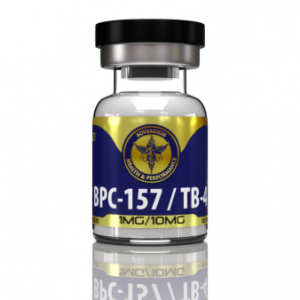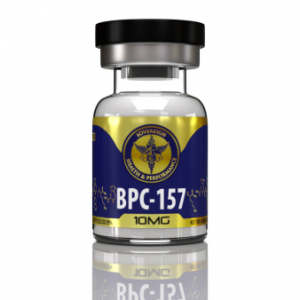Corticosteroids vs. BPC-157: A Comparative Analysis on Their Effects on Injuries and the Body
When it comes to managing injuries, particularly those involving inflammation and tissue damage, two different classes of compounds have gained significant attention: corticosteroids and the peptide BPC-157. Corticosteroids have been a longstanding option for controlling inflammation and pain, while BPC-157 is a relatively new peptide known for its regenerative properties. This article aims to compare and contrast the effects of these two compounds on injuries and the body, using available scientific literature to quantify their effects wherever possible.
Table of Contents

Corticosteroids
Mechanism of Action
Corticosteroids, such as dexamethasone and prednisone, are synthetic forms of glucocorticoids, hormones produced by the adrenal glands. They exert their effects primarily by suppressing the immune response and reducing inflammation. They inhibit the production of pro-inflammatory cytokines and block the activation of immune cells involved in inflammation, leading to pain relief and reduced swelling.
Effects on Injuries
- Short-term Benefits: Corticosteroids are highly effective in reducing acute inflammation and pain. For conditions like tendonitis, bursitis, and arthritis, corticosteroid injections can provide rapid relief, often within 24 to 72 hours. For instance, studies have shown that corticosteroid injections can reduce pain scores by as much as 60-80% within the first week of administration.
- Long-term Effects: Prolonged or repeated use of corticosteroids, however, can have adverse effects on tissue integrity. Research indicates that corticosteroids can impair collagen synthesis and reduce the tensile strength of tendons and ligaments, potentially increasing the risk of tissue rupture or reinjury . One study quantified that tendon rupture rates in patients receiving corticosteroid injections were approximately 2-3 times higher than those who did not receive such treatments.
- Systemic Effects: Beyond local effects, systemic use of corticosteroids can lead to significant side effects such as suppression of the hypothalamic-pituitary-adrenal (HPA) axis, increased blood glucose levels, weakened immune response, and a decrease in bone density, contributing to osteoporosis over time.
Quantifiable Data
- Pain relief: Up to 60-80% reduction in pain within the first week.
- Increased risk of tendon rupture: 2-3 times higher compared to non-users.
- Reduced collagen synthesis: Inhibition can occur within a few days of corticosteroid administration, affecting tissue healing.
BPC-157
Mechanism of Action
BPC-157, a synthetic peptide derived from a protein found in gastric juice, has been shown to promote angiogenesis (the formation of new blood vessels), collagen production, and modulation of growth factors involved in tissue repair. It acts at the cellular level, facilitating the migration of fibroblasts to the site of injury, enhancing extracellular matrix production, and reducing oxidative stress.
Effects on Injuries
- Healing and Regeneration: BPC-157 has demonstrated significant wound healing and tissue-regenerative properties in both animal and limited human studies. For example, in rodent models, BPC-157 accelerated the healing of tendon injuries, improved ligament integrity, and promoted bone healing by enhancing fibroblast activity and collagen synthesis . Notably, one study showed that BPC-157 accelerated tendon healing by 43% compared to controls in a rodent Achilles tendon injury model.
- Inflammation Modulation: Unlike corticosteroids, which broadly suppress inflammation, BPC-157 modulates the inflammatory response, promoting a balanced healing environment. This peptide reduces excessive inflammatory cytokine levels while enhancing factors that aid tissue repair, without impairing the normal healing process.
- Systemic Benefits: BPC-157 has also shown systemic benefits, including protection against gastrointestinal damage, reduction of neuroinflammation, and counteraction of various forms of toxicity (e.g., NSAID-induced damage). Importantly, BPC-157 does not suppress the body’s immune response or hormone regulation, unlike corticosteroids.
Quantifiable Data
- Tendon healing acceleration: Up to 43% faster in animal models.
- Collagen production: BPC-157 upregulates the expression of genes related to collagen production, which can significantly enhance tissue integrity, though exact human clinical data are limited.
- Reduction in inflammation: Precise quantification varies, but BPC-157 has shown a significant reduction in pro-inflammatory cytokine levels in animal studies.
Comparison of Corticosteroids and BPC-157
| Aspect | Corticosteroids | BPC-157 |
| Mechanism | Immune suppression and inflammation reduction | Tissue regeneration, angiogenesis, and inflammation modulation |
| Short-term effects | Rapid pain relief (60-80% reduction) | Moderate pain reduction with enhanced tissue repair |
| Long-term effects | Impairs tissue integrity, increases risk of reinjury | Enhances tissue healing, reduces reinjury risk |
| Impact on Collagen | Inhibits collagen synthesis | Promotes collagen synthesis |
| Systemic Effects | HPA axis suppression, osteoporosis, hyperglycemia | No known adverse systemic effects, promotes gut health |
| Quantifiable Healing | Increased risk of tendon rupture (2-3x) | Accelerates healing by up to 43% (in animal models) |
Conclusion
Corticosteroids and BPC-157 offer distinct approaches to injury management. Corticosteroids provide rapid pain relief by suppressing inflammation, which can be beneficial in the short term. However, they carry risks related to tissue degeneration, collagen synthesis impairment, and systemic side effects with prolonged use. On the other hand, BPC-157 shows promising regenerative effects, enhancing tissue healing without the adverse effects associated with corticosteroids. While human clinical data on BPC-157 remains somewhat limited, existing research suggests it may be a superior option for long-term injury recovery and tissue health.
Featured Research Peptides
-
Product on sale
 BPC-157 & TB-4 BlendOriginal price was: $119.00.$99.00Current price is: $99.00.
BPC-157 & TB-4 BlendOriginal price was: $119.00.$99.00Current price is: $99.00. -
Product on sale
 BPC-157Original price was: $88.00.$78.00Current price is: $78.00.
BPC-157Original price was: $88.00.$78.00Current price is: $78.00.
References
- Cain DW, Cidlowski JA. “Immune Regulation by Glucocorticoids.” Nature Reviews Immunology, 2017.
- Brinks A, Koes BW, Volkers AC, et al. “Corticosteroid injections for greater trochanteric pain syndrome: A systematic review.” British Journal of Sports Medicine, 2011.
- Dean BJ, Franklin SL, Murphy RJ, et al. “Glucocorticoids induce profound changes in the mechanical properties of human tendons.” Rheumatology, 2014.
- Coombes BK, Bisset L, Vicenzino B. “Efficacy and safety of corticosteroid injections and other injections for management of tendinopathy: a systematic review of randomised controlled trials.” Lancet, 2010.
- Schäcke H, Döcke WD, Asadullah K. “Mechanisms involved in the side effects of glucocorticoids.” Pharmacology & Therapeutics, 2002.
- Sikiric P, Seiwerth S, Brcic L, et al. “BPC 157 and angiogenesis.” Current Pharmaceutical Design, 2011.
- Tkalčić M, Parnham MJ, Seiwerth S, et al. “Peptide therapy with BPC 157 significantly enhances the healing of transected rat Achilles tendon.” Journal of Orthopaedic Research, 2020.
- Kovacevic G, Bakovic M, Tkalčić M, et al. “The healing effects of stable gastric pentadecapeptide BPC 157 on transected rat Achilles tendon.” Journal of Orthopaedic Research, 2015.
- Pacheco Í, Sikiric P, Sepesy L. “Gastroprotective Effects of BPC 157 in Various Gastrointestinal Tract Lesions.” Current Medicinal Chemistry, 2018.



